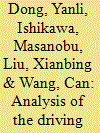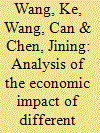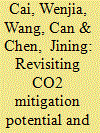|
|
|
Sort Order |
|
|
|
Items / Page
|
|
|
|
|
|
|
| Srl | Item |
| 1 |
ID:
094298


|
|
|
|
|
| Publication |
2010.
|
| Summary/Abstract |
This paper examines CO2 emissions embodied in Japan-China trade. Besides directly quantifying the flow of CO2 emissions between the two countries by using a traditional input-output (IO) model, this study also estimates the effect of bilateral trade to CO2 emissions by scenario analysis. The time series of quantifications indicate that CO2 emissions embodied in exported goods from Japan to China increased overall from 1990 to 2000. The exported CO2 emissions from China to Japan greatly increased in the first half of the 1990s. However, by 2000, the amount of emissions had reduced from 1995 levels. Regardless, there was a net export of CO2 emissions from China to Japan during 1990-2000. The scenario comparison shows that the bilateral trade has helped the reduction of CO2 emissions. On average, the Chinese economy was confirmed to be much more carbon-intensive than Japan. The regression analysis shows a significant but not perfect correlation between the carbon intensities at the sector level of the two countries. In terms of CO2 emission reduction opportunities, most sectors of Chinese industry could benefit from learning Japanese technologies that produce lower carbon intensities.
|
|
|
|
|
|
|
|
|
|
|
|
|
|
|
|
| 2 |
ID:
099274


|
|
|
|
|
| Publication |
2010.
|
| Summary/Abstract |
By using the latest China-Japan input-output data sets and the index decomposition analysis (IDA) approach, this article analyzes the driving forces of CO2 emissions embodied in trade between the two countries during 1990-2000. We found that the growth of trade volume had a large influence on the increase of CO2 emissions embodiments in bilateral trade. The dramatic decline in carbon intensity of the Chinese economy is a primary cause in offsetting CO2 emissions exported from China to Japan over 1995-2000. We argue that a better understanding of the factors affecting CO2 emissions embodied in international trade will assist in seeking more effective climate policies with wider participation in the post-Kyoto regime.
|
|
|
|
|
|
|
|
|
|
|
|
|
|
|
|
| 3 |
ID:
088959


|
|
|
|
|
| Publication |
2009.
|
| Summary/Abstract |
Abatement cost is the main concern for climate change mitigation and the key factor for mitigation cost is technological change. This study established an integrated economic, energy, environmental, dynamic, computable general equilibrium (CGE) model representing endogenous technological change for China's climate change policy analysis. This study analyzed and compared the economic impact of different approaches to mitigation commitments as well as the potential role of technological change in the formulation of mitigation targets and commitments, taking into account China's climate policy-making needs based on the current international climate negotiation process. The results show that, absolute emission limits similar to the Kyoto Protocol will seriously impede the future economic development of China, while the impact of an 80% reduction in carbon intensity, forecast for 2050 based on the 2005 level, is relatively small. Technological change can promote economic growth, improve energy efficiency and reduce carbon intensity per unit of output through the substitution of production factors. Consequently it can reduce marginal abatement cost and related GDP loss by mitigation. At the same time it can increase mitigation potentials and extend the emission reduction amount, showing that consideration of the impact of technological change when deciding the emission reduction targets is necessary
|
|
|
|
|
|
|
|
|
|
|
|
|
|
|
|
| 4 |
ID:
108602


|
|
|
| 5 |
ID:
125434


|
|
|
|
|
| Publication |
2013.
|
| Summary/Abstract |
There are continuous debates around the question of whether CDM really contributes to sustainable development (SD) in host countries. Employment impact is an essential indicator of SD. Based on an input-out approach this research builds a quantitative assessment model to evaluate the employment impacts of CDM. Both direct and indirect jobs creation and job losses of CDM projects in the power sector registered by the end of 2011 are calculated by project types and power grids where the project is located. Results of this study show that, although the above mentioned CDM projects causes about 99,000 net direct job losses, they also create about 3.08 million indirect jobs, resulting in the gross employment of CDM to be about 2.98 million. Thereof, hydro projects induce both direct and indirect job losses, which comes to approximately 0.89 million. Solar projects have the most potential since they own the highest indirect jobs created by one GWh generation, about 104 jobs/GWh.
|
|
|
|
|
|
|
|
|
|
|
|
|
|
|
|
| 6 |
ID:
097264


|
|
|
|
|
| Publication |
2010.
|
| Summary/Abstract |
To improve the reliability of sectoral mitigation potential and cost analysis, this paper made an in-depth exploration into China's electricity sector's thermal efficiency and inner structure. It is found that unlike what many literatures portray, China is actually among the world's leaders in coal-fired power plants' generating efficiencies; besides, although there are still numerous small and inefficient generating units in the current generation fleet, many of them are in fact playing important roles in supporting local economic development, meeting peak load needs, balancing heat and electricity supply and providing job opportunities to the local economy, therefore their existence does not necessarily mean low-cost mitigation potential. Given the efficiency and structural characteristics of China's electricity sector, it is pointed out that some other mitigation options, such as demand side management, IGCC and renewable energy as well as the break-through of CCS technology may play an even more important role in emission reduction. Considering the significant lock-in effects in electricity sector, it is warned that China, if continues putting majority investment in large and advanced coal-fired generating units, will face another round of chasing-after for the new and advanced renewable generation technologies. Therefore China should put more efforts in renewable generation technologies now.
|
|
|
|
|
|
|
|
|
|
|
|
|
|
|
|
| 7 |
ID:
116936


|
|
|
|
|
| Publication |
2012.
|
| Summary/Abstract |
Despite high-speed economic growth in recent decades, rural China is still confronted with persisting poverty, alongside energy shortages and environmental degradation. In tackling climate change, carbon emissions from rural energy use have been given little attention up till now. This paper provides an analysis of rural residential CO2 emissions in China based on diverse accounting methods, and employs the geographic information system (GIS) to map emissions of each province. Identifying the major emission sources could provide a basis for understanding the potential for greenhouse gas emission reduction and proposing related policy recommendations. The results showed that the largest GHG mitigation potential can be found at traditional biomass use among residents. Four emission reduction policy strategies are identified: (i) shifting to commercial energy; (ii) furthering the use of decentralized renewable energy options; (iii) commercializing biomass energy via biomass power generation, biomass briquettes and biogas production; (iv) improving the combustion efficiency of traditional biomass use in household appliances. Differences in resource endowment and local economic conditions created varied levels of rural residential greenhouse gas emission, the related mitigation potential, and the kinds of strategies and policies that need to be developed in the Chinese provinces.
|
|
|
|
|
|
|
|
|
|
|
|
|
|
|
|
| 8 |
ID:
115177


|
|
|
|
|
| Publication |
2012.
|
| Summary/Abstract |
Based on the review of the basic design of the sectoral crediting mechanism (SCM) - a promising option for developing countries' emission reduction commitments - this paper analyzes five important practical issues for China to solve before participating in SCM, which include (1) difficulties in determining a crediting baseline (2) the unsolved over-supply problem in the carbon market (3) the very likely "carbon credits falling short of mitigation costs" problem (4) the immature market-oriented price system jeopardizing the success of motivation incentives and (5) inadequate capacity building. Corresponding suggestions or compromise solutions are given after a discussion of each issue. It is also recommended that in order to witness SCM come into being, researchers and negotiators should endeavor to solve the practical issues that SCM meets now, bearing in mind the balance of interests of both developing and developed countries. Finally we believe that SCM's political barriers can be overcome when technical, economic institutional and capacity problems are solved.
|
|
|
|
|
|
|
|
|
|
|
|
|
|
|
|
|
|
|
|
|